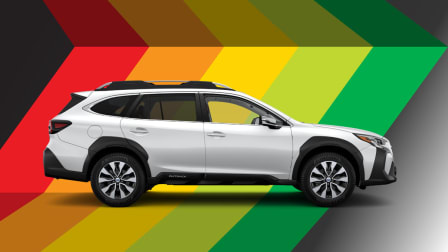How to Make Your Car More Accessible for Aging, Injury, Disability, or Pregnancy
Adapt your vehicle to make it more comfortable without compromising safety
Tom Wiebell knows a lot about cars. During his career as a radio broadcaster around Columbus, Ohio, he reported on and road-tested new vehicles. When he realized he was having trouble seeing over the hood of his 1997 Mazda Miata, he added a small seat cushion. And when he learned about a free program called CarFit designed to help older drivers find the safest and most comfortable seating position, he went to one of its events to report on it for his radio program.
“I was so impressed with it, and of course, being an older person, I was genuinely interested in seeing if there was something I was overlooking,” the 89-year-old told Consumer Reports.
But before you click “Buy Now,” you might want to follow Wiebell’s lead and talk to a trained professional first. Sometimes that’s as simple as asking a healthcare provider who is already helping you with the issue that’s making driving more challenging.
For major alterations that change how a car drives, you’ll likely want to avoid the DIY approach altogether and consult with a certified driving rehabilitation specialist (CDRS).
“Some modifications might seem minor, but they can have significant effects on the safety of your vehicle, such as how the seat belts and airbags operate,” says Jennifer Stockburger, director of operations at Consumer Reports’ auto test center. “Other changes may sound like a good idea, but may not actually provide the help you need.”
We put together a list of easy, inexpensive modifications you can make yourself, including some useful gadgets that you might not have thought about, or features that your car may already have. We also talked to certified driving rehabilitation specialists and CarFit trainers for advice on when—and how—to get help from a specialist.
When Not to DIY
If you plan to modify your vehicle’s braking, steering, or acceleration, or if you’re looking to purchase a wheelchair-accessible vehicle, stop and talk to a professional, says Susie Touchinsky, an occupational therapist and CDRS. Installing items such as pedal extenders that attach to the accelerator and brake, or hand controls and spinner knobs for steering on your own could be dangerous. In many states, drivers who use these devices may need to have a restriction added to their licenses as well.
“If you’re changing how your car starts, stops, or steers, that’s really when you need to work with a specialist to make sure you get the right equipment,” she says.
Even if you aren’t making major changes, a CDRS can keep you from wasting money on modifications that aren’t right for you. “I have people who will shop on the internet, then they get connected with me, and what they think they want is not what they end up with,” says Touchinsky.
If that sounds like the kind of assistance you or a loved one needs, check the American Occupational Therapy Association’s list of driving rehabilitation providers to find one near you. A consultation usually lasts about three hours, and depending on the practitioner can either be done at a medical facility or at the driver’s home, Touchinsky says.
Simpler Fixes
Modifications that don’t change how a car drives can be installed without professional help or state approval, although you’ll still want to at least consult with a healthcare provider to make sure those modifications are the best fit for your needs. For example, your primary care provider, the occupational therapist who is helping you with an existing issue, or your OB/GYN if you’re pregnant may all be able to help. Such a consultation may be covered by insurance.
Some examples of simple modifications that can improve accessibility include:
Seat belt grabber (shown below, $8-$10): If you have difficulty reaching across or behind you, this simple and inexpensive add-on makes it easier to pull a shoulder belt across your body.
Cushion for an ostomy bag, port, implanted medical device, or surgical wound ($12-$100): Drivers or passengers who have an implanted port, ostomy bag, implanted medical device such as a pacemaker, or surgical wound can find seat belts uncomfortable. As a result, they may not buckle up, which puts their lives in danger in a crash, says Elin Schold-Davis, an occupational therapist and CDRS who coordinates the American Occupational Therapy Association’s older driver initiative. Various cushions and shields are available that make the belt more comfortable.
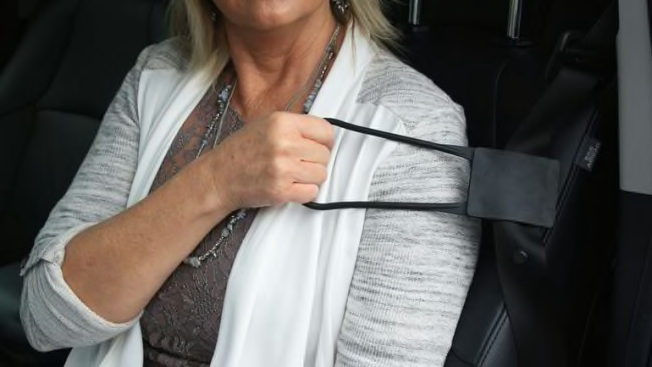
Photo: Stander Photo: Stander
Blind-spot mirror (shown below, $5-$30): Stick-on or clip-on mirrors for the side and rear view can give drivers a better view of the road if they have difficulty turning their head to check a blind spot. However, if a driver is installing additional mirrors due to hearing loss, they may need to have a restriction added to their license in some states.
HandyBar ($25-$50): As the program director for Silver Drivers Safe Texans at Texas A&M AgriLife extension service, Cindy Kovar helps senior drivers throughout Texas, including at CarFit workshops. She often sees drivers and passengers who have trouble getting in and out of their car.
“Sometimes they’ll try and rig up something to help them get out of the vehicle,” she said. Instead, she’ll usually recommend they get a HandyBar (or a similar generic brand), a small device that hooks into your car’s striker plate—the hook or bolt in a car’s door frame where the door latches—and provides a steady grip. “It’s a very strong part of the car so they can lift themselves out,” she says. These can also be helpful for pregnant drivers, says Touchinsky, who used one herself.
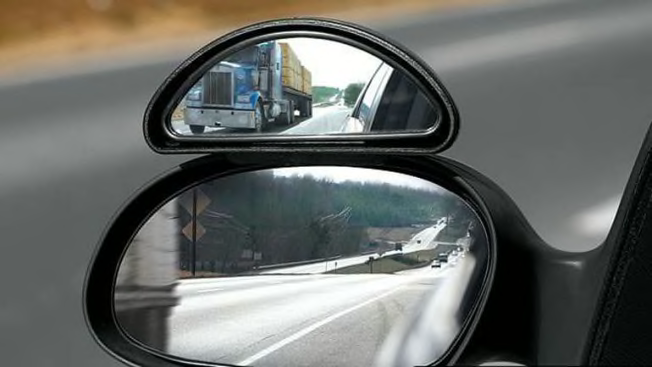
Photo: Hercules Photo: Hercules
Buckle booster (shown below, $8-$12): This simple foam block keeps seat belt buckles from falling behind the seat cushions. It also steadies the buckle so it’s easier to insert the metal tongue into the buckle. Touchinsky recommends it for any passenger who might have difficulty using two hands to simultaneously steady the buckle and hold the belt.
Many of these items are available at online retailers as well as medical supply stores.
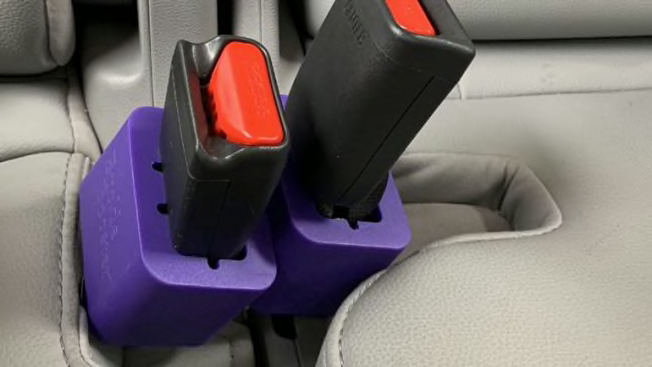
Photo: Buckle Booster Photo: Buckle Booster
Be Aware of Trade-Offs
Some of these modifications may add a small safety risk. For example, a seat cushion can help if you can’t easily see over the steering wheel, which can happen as your body ages. It can also add comfort if your back hurts on long trips. However, a cushion might also make it more likely for an occupant to slide under the lap belt in a crash, which could cause ankle injuries. “There’s a trade-off,” says Schold-Davis. “But if you can see over the dash, you may feel that’s worth it.” She says anyone using a cushion should ensure their seat belt is buckled low and tight across their hips and talk to a doctor or an occupational therapist before adding one to ensure the trade-off is worth it.
Check your car’s owner’s manual to see if there are any restrictions specific to your vehicle, Stockburger says. “Some owner’s manuals caution against things like pillows and cushions, as they can interfere with airbag deployment,” she says. In some cases, a seat cover could get in the way of an airbag. In others, a cushion may confuse the vehicle’s sensors that determine whether an airbag should or shouldn’t go off.
Your Car Might Already Have Features Built In
Touchinsky says that in her experience, many modern cars’ built-in advanced driver assistance systems can help drivers with mobility problems. For example, for people who have difficulty turning their heads, blind spot warning (BSW) and backup cameras can make it easier to see around a vehicle.
And if you’re in the market for a new vehicle, Stockburger says to look for vehicles that have seat heights and door openings that make entering and exiting easier. “Both very low and high vehicles can be difficult,” she says. “Power seat adjustments, including lumbar support, and steering wheels that can tilt and telescope can also make tailoring your driving position easier.”
Free Help for Older Drivers
You might also be able to optimize the car you already own without making any modifications. Older drivers can take advantage of CarFit, a free nationwide educational program developed with AAA, AARP, and the American Occupational Therapy Association designed to help older drivers find comfortable and safe seating positions. During a 20-minute consultation, trained professionals will guide drivers through 12 steps to sitting more safely and comfortably.
“The program itself is geared for 55-plus but we don’t turn anybody away,” says Kovar. “Somebody may bring in their mother or grandmother, and we’ll go ahead and help them, too. If a husband and wife both drive a car, we’ll adjust it for both of them.”
Among the most important changes Kovar helps drivers make are ensuring the seat belt is adjusted properly so it doesn’t cut across the necks or sit too high on the abdomen, which isn’t just uncomfortable but could also increase the risk of injury. She also helps them adjust their mirrors. And if a car has a memory button for its power seats, she’ll program it so drivers don’t lose their new seating position.
If there’s no CarFit event near you, the CarFit website can help you set up your own vehicle. “They have some fantastic videos if you’re unable to attend an event,” Kovar says, although she recommends in-person instruction. You can also attend a live virtual event.
Help for Caregivers
If you’re caring for someone who needs assistance getting in and out of a vehicle, Schold-Davis recommends that you reach out to an occupational therapist to ensure you don’t injure yourself.
Solutions range from inexpensive transfer sheets that help passengers slide into a car seat to costly power lifts that bring a passenger up into a vehicle at the push of a button. In some cases, it may make more sense to hire a medical transport service than to modify an existing vehicle.
Even though some of these adaptations may be expensive, Schold-Davis says they’re worth it if they protect the health of a caregiver and the person they’re caring for. “We wear out our caregivers,” she says. “People’s health is worth something, their bodies are worth something,” she says.
Modified Vehicles and Wheelchair Vans
If you plan to install adaptive equipment such as hand controls, or purchase a converted vehicle such as a wheelchair van, you’ll want to consult with a CDRS first. This equipment is not usually covered by insurance and can be expensive—wheelchair-accessible minivans can cost tens of thousands of dollars more than an unmodified model, for example.
Some drivers try to make bigger modifications without the help of a professional. But by hooking up pedal extenders or hand controls on their own, they put themselves and other road users at risk, says Schold-Davis. “I think somehow people think they need to figure it out themselves, and they’re admitting defeat if they’re getting a consult from somebody,” she says.
But talking to a CDRS first—before you buy a specialized vehicle or pay for modifications—could save you more money in the long run or prevent future injury, says Schold-Davis.
“Their answer might be something that’s very low-tech and very inexpensive that’s the right thing for you,” she says. “They’re also experts in helping you find the funding if it’s available.” For example, local and national charities can sometimes help defray the cost of such a purchase.
Fran Hummer of Mechanicsburg, Pa., started working with Touchinsky after a double amputation.
“I decided, ‘I’m not going to be dependent, and I’m going to figure out how to drive,’” she told CR.
She knew cars could be fitted with hand controls, and she found a used Toyota Sienna wheelchair van on her own. Then, the dealership she purchased it from recommended that she meet with a CDRS to customize the vehicle for her needs.
Touchinsky helped her set up hand controls for the accelerator and brake, taught her how to use them, and prepared her for her driving test. She also taught Hummer how to convert her minivan back to conventional operation so that someone else could drive it. Indeed, the National Highway Traffic Safety Administration (NHTSA) recommends that drivers bring a friend or family member along for training so they can learn how to drive the modified vehicle in case the primary driver is unable.
Hummer said it cost just under $8,000 for a specialized mechanic to install the hand controls she needed—a cost that can vary widely depending on an individual driver’s needs. But she says it’s worth it to be able to drive to church, to the beach, and to her children’s houses.


















